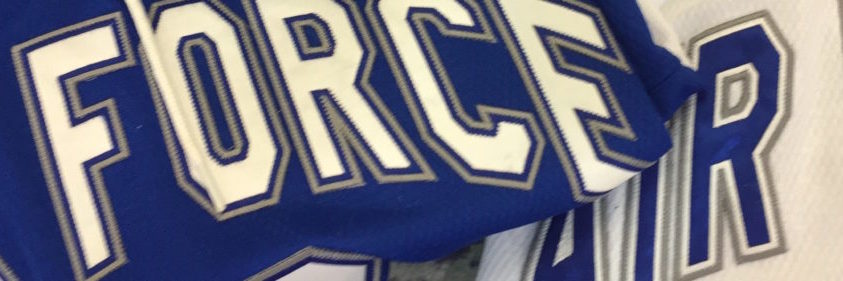If you’re looking for one reason why the Falcons didn’t reach the first of their goals – the final four of the Atlantic Hockey Conference tournament – you could point a finger at the offense, which had its worst season in the four this senior class was at the Academy.
That’s not to say the senior class, which won a program-record-tying 86 games, are to blame because they scored 37 of the Falcons’ 90 goals and included this season’s top four scorers.
It’s too bad Air Force couldn’t find more ways to generate offense, especially at even strength, because it had many of the other ingredients necessary for playoff success – specifically an excellent goaltender, a solid team defense and very good to excellent special teams.
What follows is the Flight Path’s analysis of the three main areas – offense, defense and special teams, and how they compare with the past three seasons, when Air Force twice battled to the NCAA Tournament’s final eight and very nearly played for an AHC title the year before those runs.
Offense
The Falcons were dealt a crushing blow in Game 3 of the season when senior left wing Matt Serratore, one of the team’s best players, was lost to an upper body injury that ultimately sidelined him for the season. Serratore was an every-situation player who had the potential to put up 30 points.
The Falcons were in a similar situation last season when center Evan Feno went down in the first game with a torn ACL, but they also were a deeper, more veteran team in 2017-18.
Without Serratore, more of the burden for scoring on the wings shifted to senior Evan Giesler, juniors Trevor Stone and Matt Pulver, sophomores Marshall Bowery and Walker Sommer and freshman Kieran Durgan. Durgan was a revelation with 12 goals, and Sommer and Stone each had nine. No other wings managed more than seven.
Feno and fellow senior center Kyle Haak each had 22 points and were in double figures in goals, while junior Brady Tomlak chipped in 18 points, including eight goals.
The defense managed just nine goals – four by senior Matt Koch, who led the team with 24 points – and 75 points. For some context, two seasons ago the defense added 22 goals and 93 points. The difference mainly was the goals.
Of the Falcons’ 90 goals, just 47 came on even strength. Seventeen were power-play strikes, 10 were empty-netters and two came shorthanded.
For comparison’s sake, the Falcons had scored 115, 133 and 110 goals the previous three seasons, and 78, 86 and 80 even-strength goals. That is a huge difference. And it was manifest this season in being shutout an almost unthinkable six times and being held to one goal six more times.
They also had by far their worst shooting percentage in the past four years (8.6). The previous three seasons saw accuracy marks of 9.5 percent, 10.5 percent and 9.5 percent. Goal scoring was a constant battle, and one would have to think shooting acumen is a high priority for recruiting.

Billy Christopoulos was a rock in net all season for Air Force. Photo courtesy of Russ Backer and Air Force Athletics
Defense
Early in the season goaltender Billy Christopoulos covered for some mistakes by a youthful defense that returned only two upperclassmen in Koch and fellow senior Dan Bailey, whom coach Frank Serratore said was one of the team’s most improved players.
Particularly after the Christmas break, the Falcons tightened things up, and a trio of sophomores – Zack Mirageas, Jake Levin and Alex Mehnert – were big reasons why. So it’s fairly remarkable that after graduating four seniors, the Falcons gave up about the same amount of goals they typically had. Their 92 allowed compared favorably with the 94, 93 and 86 of the three previous seasons.
Christopoulos had another strong season, arguably even stronger than he did in 2017-18, when his numbers were slightly better. His 2.24 goals-against average this season was a bit higher than the previous season’s 2.06, and his .914 save percentage compared with a .922. He had three shutouts. He overcame a midseason illness that required surgery, but aside from that was asked to win games a bit too often.
This also was one of the Falcons’ stronger face-off teams at 54.8 percent, which was fourth in Division I. Two seasons ago, they were at 54.9 percent before falling to 51.9 percent last season, when they suffered a rash of injuries in the middle.
Special teams
This was a clear strong point of the team, maybe its strongest point.
The Falcons finished first in Division I in penalty killing at 88.9 percent and they were 18th in power play at almost 21 percent.
The man advantage was 50 percent better than last season’s 14 percent and even better than 2016-17’s 18.1 percent in a campaign they scored 133 goals.
The PK was good even by Air Force standards – a reflection of both Christopoulos’ play and the team-wide commitment when a man down. In the three previous seasons, the Falcons were at 84.1 percent, 89.7 percent and 85.5 percent.
The latter is a reflection on the work ethic, smarts and will of Serratore’s teams.
Summary
Expectations were high at Cadet Arena, and justifiable so. The Falcons had another strong senior class, led by an elite goaltender. They’re not a team that beats themselves very often and they have one of the best coaching staffs in D-I hockey.
The Matt Serratore injury was a crusher, and the Falcons never really went on one of their patented runs. They’d play well for a few weeks, then struggle for 2-3 games, then regroup. It seemed as though that playlist was on repeat all season.
They played better at the end of the season, but so did their opponents, and the dearth of offense, particularly at five on five, hurt them the most.
©First Line Editorial 2017-19





